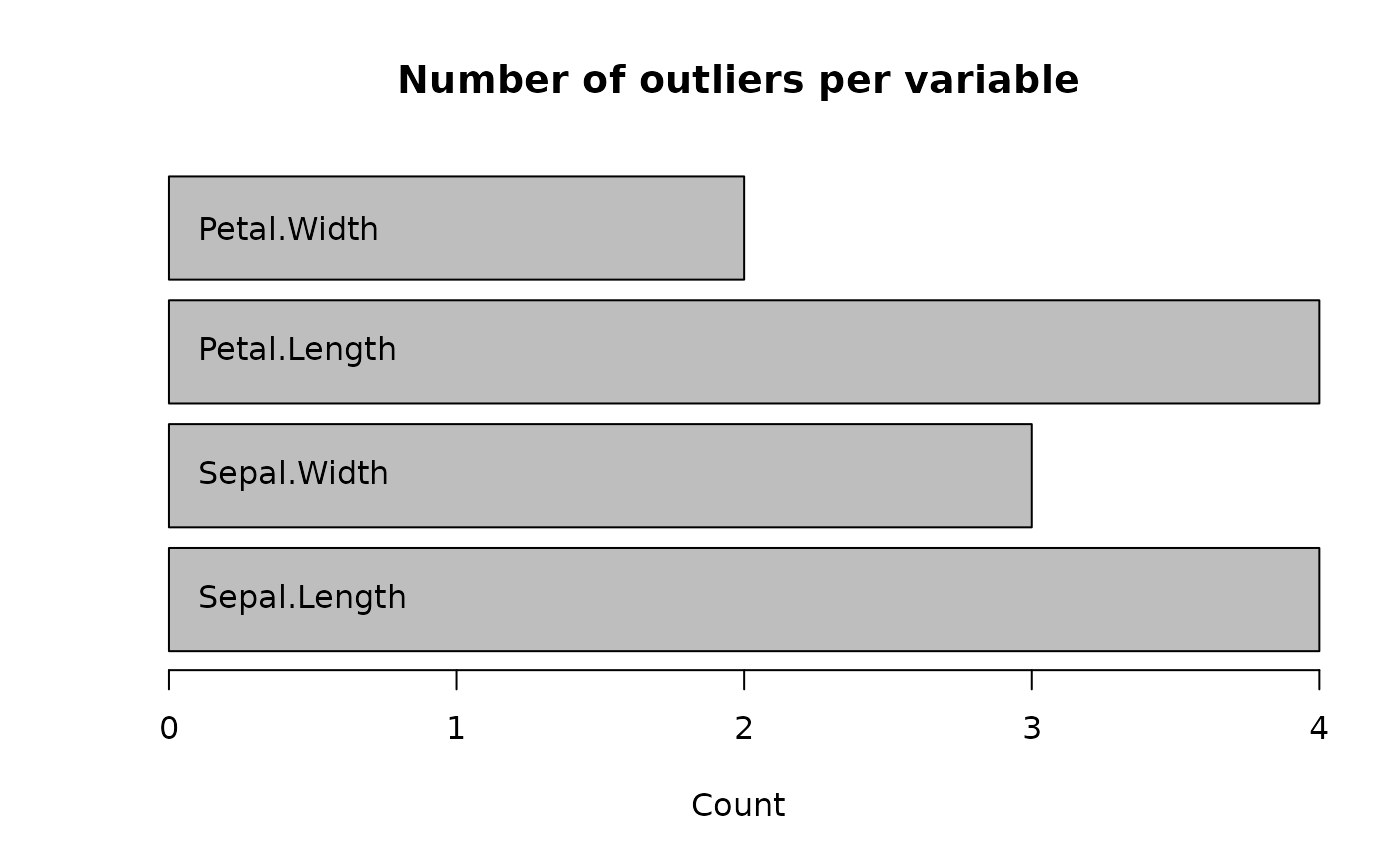This function provides a random forest based implementation of the method described in Chapter 7.1.2 ("Regression Model Based Anomaly detection") of Chandola et al. Each numeric variable to be checked for outliers is regressed onto all other variables using a random forest. If the scaled absolute difference between observed value and out-of-bag prediction is larger than some predefined threshold (default is 3), then a value is considered an outlier, see Details below. After identification of outliers, they can be replaced, e.g., by predictive mean matching from the non-outliers.
outForest(
data,
formula = . ~ .,
replace = c("pmm", "predictions", "NA", "no"),
pmm.k = 3L,
threshold = 3,
max_n_outliers = Inf,
max_prop_outliers = 1,
min.node.size = 40L,
allow_predictions = FALSE,
impute_multivariate = TRUE,
impute_multivariate_control = list(pmm.k = 3L, num.trees = 50L, maxiter = 3L),
seed = NULL,
verbose = 1,
...
)Arguments
- data
A
data.frameto be assessed for numeric outliers.- formula
A two-sided formula specifying variables to be checked (left hand side) and variables used to check (right hand side). Defaults to
. ~ ., i.e., use all variables to check all (numeric) variables.- replace
Should outliers be replaced via predictive mean matching "pmm" (default), by "predictions", or by
NA("NA"). Use "no" to keep outliers as they are.- pmm.k
For
replace = "pmm", from how many nearest OOB prediction neighbours (from the original non-outliers) to sample?- threshold
Threshold above which an outlier score is considered an outlier. The default is 3.
- max_n_outliers
Maximal number of outliers to identify. Will be used in combination with
thresholdandmax_prop_outliers.- max_prop_outliers
Maximal relative count of outliers. Will be used in combination with
thresholdandmax_n_outliers.- min.node.size
Minimal node size of the random forests. With 40, the value is relatively high. This reduces the impact of outliers.
- allow_predictions
Should the resulting "outForest" object be applied to new data? Default is
FALSE.- impute_multivariate
If
TRUE(default), missing values are imputed bymissRanger::missRanger(). Otherwise, by univariate sampling.- impute_multivariate_control
Parameters passed to
missRanger::missRanger()(only if data contains missing values).- seed
Integer random seed.
- verbose
Controls how much outliers is printed to screen. 0 to print nothing, 1 prints information.
- ...
Arguments passed to
ranger::ranger(). If the data set is large, use less trees (e.g.num.trees = 20) and/or a low value ofmtry.
Value
An object of class "outForest" and a list with the following elements.
Data: Original data set in unchanged row order but optionally with outliers replaced. Can be extracted with theData()function.outliers: Compact representation of outliers, for details see theoutliers()function used to extract them.n_outliers: Number of outliers perv.is_outlier: Logical matrix with outlier status.NULLifallow_predictions = FALSE.predData:data.framewith OOB predictions.NULLifallow_predictions = FALSE.allow_predictions: Same asallow_predictions.v: Variables checked.threshold: The threshold used.rmse: Named vector of RMSEs of the random forests. Used for scaling the difference between observed values and predicted.forests: Named list of fitted random forests.NULLifallow_predictions = FALSE.used_to_check: Variables used for checkingv.mu: Named vector of sample means of the originalv(incl. outliers).
Details
The method can be viewed as a multivariate extension of a basic univariate outlier
detection method where a value is considered an outlier if it is more than, e.g.,
three times the standard deviation away from its mean. In the multivariate case,
instead of comparing a value with the overall mean, rather the difference to the
conditional mean is considered. outForest() estimates this conditional
mean by a random forest. If the method is trained on a reference data with option
allow_predictions = TRUE, it can even be applied to new data.
The outlier score of the ith value \(x_{ij}\) of the jth variable is defined as \(s_{ij} = (x_{ij} - p_{ij}) / \textrm{rmse}_j\), where \(p_{ij}\) is the corresponding out-of-bag prediction of the jth random forest and \(\textrm{rmse}_j\) its RMSE. If \(|s_{ij}| > L\) with threshold \(L\), then \(x_{ij}\) is considered an outlier.
For large data sets, just by chance, many values can surpass the default threshold
of 3. To reduce the number of outliers, the threshold can be increased.
Alternatively, the number of outliers can be limited by the two arguments
max_n_outliers and max_prop_outliers. For instance, if at most ten outliers
are to be identified, set max_n_outliers = 10.
Since the random forest algorithm "ranger" does not allow for missing values, any missing value is first being imputed by chained random forests.
References
Chandola V., Banerjee A., and Kumar V. (2009). Anomaly detection: A survey. ACM Comput. Surv. 41, 3, Article 15 <dx.doi.org/10.1145/1541880.1541882>.
Wright, M. N. & Ziegler, A. (2016). ranger: A Fast Implementation of Random Forests for High Dimensional Data in C++ and R. Journal of Statistical Software, in press. <arxiv.org/abs/1508.04409>.
Examples
head(irisWithOut <- generateOutliers(iris, seed = 345))
#> Sepal.Length Sepal.Width Petal.Length Petal.Width Species
#> 1 5.1 3.5 1.4 0.2 setosa
#> 2 4.9 3.0 1.4 0.2 setosa
#> 3 4.7 3.2 1.3 0.2 setosa
#> 4 4.6 3.1 1.5 0.2 setosa
#> 5 5.0 3.6 1.4 0.2 setosa
#> 6 5.4 3.9 1.7 0.4 setosa
(out <- outForest(irisWithOut))
#>
#> Outlier identification by random forests
#>
#> Variables to check: Sepal.Length, Sepal.Width, Petal.Length, Petal.Width
#> Variables used to check: Sepal.Length, Sepal.Width, Petal.Length, Petal.Width, Species
#>
#> Checking: Sepal.Length Sepal.Width Petal.Length Petal.Width
#> I am an object of class(es) outForest and list
#>
#> The following number of outliers have been identified:
#>
#> Number of outliers
#> Sepal.Length 4
#> Sepal.Width 3
#> Petal.Length 4
#> Petal.Width 2
outliers(out)
#> row col observed predicted rmse score threshold
#> 5 34 Sepal.Width -8.049668 3.52262141 1.236004 -9.362667 3
#> 13 137 Petal.Width -11.414393 1.92692803 1.477561 -9.029287 3
#> 8 14 Petal.Length 20.118421 0.44364273 3.036131 6.480213 3
#> 4 144 Sepal.Length -7.694186 6.03453851 2.265894 -6.058855 3
#> 1 16 Sepal.Length 18.192743 5.02003503 2.265894 5.813470 3
#> 10 144 Petal.Length -11.435635 5.54842165 3.036131 -5.593980 3
#> 2 40 Sepal.Length -7.414174 5.00302348 2.265894 -5.480043 3
#> 3 135 Sepal.Length 18.474192 6.20237447 2.265894 5.415883 3
#> 11 145 Petal.Length -10.274621 5.27119073 3.036131 -5.120270 3
#> 12 7 Petal.Width -7.038319 0.04314408 1.477561 -4.792670 3
#> 9 33 Petal.Length -9.622427 2.00996334 3.036131 -3.831320 3
#> 7 145 Sepal.Width 6.519407 2.39920688 1.236004 3.333485 3
#> 6 67 Sepal.Width 6.839742 2.83756540 1.236004 3.237998 3
#> replacement
#> 5 3.700000
#> 13 1.900000
#> 8 1.500000
#> 4 6.300000
#> 1 4.900000
#> 10 5.300000
#> 2 4.900000
#> 3 6.200000
#> 11 5.100000
#> 12 0.200000
#> 9 -6.769464
#> 7 2.500000
#> 6 2.900000
head(Data(out))
#> Sepal.Length Sepal.Width Petal.Length Petal.Width Species
#> 1 5.1 3.5 1.4 0.2 setosa
#> 2 4.9 3.0 1.4 0.2 setosa
#> 3 4.7 3.2 1.3 0.2 setosa
#> 4 4.6 3.1 1.5 0.2 setosa
#> 5 5.0 3.6 1.4 0.2 setosa
#> 6 5.4 3.9 1.7 0.4 setosa
plot(out)
 plot(out, what = "scores")
plot(out, what = "scores")
